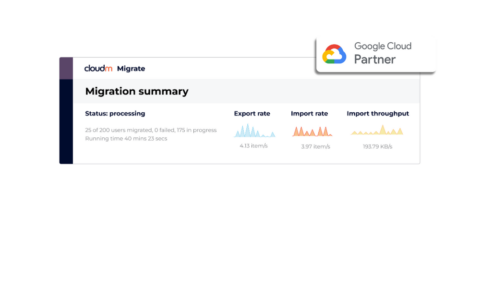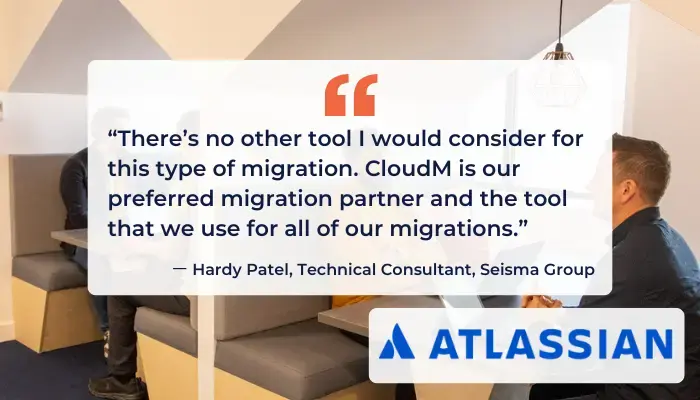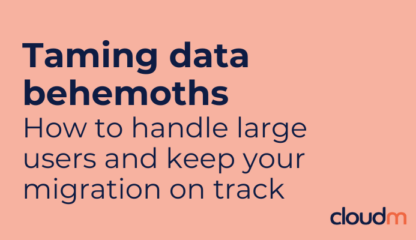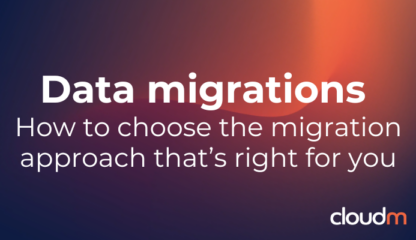

CloudM: The leading alternative to Movebot - fast, seamless and secure cloud data migrations
Both CloudM and Movebot offer data migration tools packed with features to simplify data migrations, integrations with multiple cloud platforms and provide dedicated customer support. But, which tool is right for your cloud data migration?
Request a demoCloudM vs. Movebot – Which solution is right for you?
CloudM and Movebot both offer highly regarded data migration tools packed full of features that make moving your data fast, seamless and secure. But, if you’re looking to migrate data to Google Workspace or Microsoft 365, which operator should you choose? Take a look at the detailed feature comparison below and discover why CloudM is the obvious choice for migrations to Google Workspace or Microsoft 365 from over 20 source platforms.
What differentiates CloudM and Movebot?
While both CloudM and Movebot facilitate data migration, their core philosophies and target users differ significantly. Movebot offers a broader, more generalized approach, supporting a wide array of platforms. In contrast, CloudM sets itself apart through its deep and specialized focus on the Google Workspace and Microsoft 365 ecosystems, a distinction frequently praised by its users.
CloudM’s strengths:
Proven expertise for Google Workspace and Microsoft 365 data migrations
Users consistently highlight CloudM’s superior handling of the intricacies within Google Workspace and Microsoft 365. Unlike Movebot’s more universal approach, CloudM provides granular control over aspects critical to these platforms, such as complex user provisioning, intricate permission mapping, and the management of shared resources like calendars and groups. Reviewers often note that Movebot, while versatile, may lack the same level of platform-specific sophistication.
A key advantage of CloudM, often cited in user feedback, is its integration of migration with a broader suite of management tools. Beyond the initial data transfer, CloudM offers robust features for automation, archiving, backup, and email signature management for Google Workspace. This makes CloudM a more strategic, long-term solution for organizations deeply invested in Google Workspace, offering ongoing value beyond the initial migration.
Pre-migration intelligence and expert support
CloudM users frequently commend the platform’s thorough pre-migration analysis. This proactive approach helps identify potential issues within the source environment, ensuring a smoother and more predictable migration – a level of insight that may be less emphasized in Movebot’s broader platform support. Furthermore, while Movebot offers comprehensive support, CloudM’s users often highlight the value of working with a team deeply knowledgeable in the nuances of Google Workspace and Microsoft 365, providing tailored guidance and expertise specific to these environments.
Security and Compliance
Security is another area where CloudM’s focused approach shines. Its certifications, such as ISO 27001, and emphasis on secure practices resonate strongly with organizations prioritizing data protection within their primary productivity suites. While Movebot also prioritizes security, CloudM’s specific alignment with the security requirements of Google Workspace and Microsoft 365 is often seen as a significant advantage by its users.
Movebot’s strengths: Versatility and simplicity
Movebot’s strength lies in its broad platform compatibility and ease of use. For organizations with diverse storage environments beyond market leaders Google Workspace and Microsoft 365, Movebot offers a single tool to manage migrations across various systems. Its straightforward process and interface are often praised for their simplicity. However, for organizations primarily focused on Google Workspace or Microsoft 365, this broader approach may mean less specialized features compared to CloudM.
The verdict:
If your organization’s primary focus is migrating to or between Google Workspace and Microsoft 365 tenants, and you value deep platform-specific control, comprehensive ongoing management tools, proactive pre-migration analysis, and expert support tailored to these ecosystems, CloudM is the more strategic and powerful choice. While Movebot offers broader compatibility and ease of use for diverse migration scenarios, CloudM’s dedicated expertise in the Google and Microsoft clouds provides a more robust and feature-rich solution for these specific environments, as consistently reflected in user reviews.
Feature comparison

|

|
|
|---|---|---|
Support & Services |
||
| Professional services expertise ? Skilled team to ensure migration success (additional costs apply). |
Skilled team to ensure migration success (additional costs apply).
|
|
| Serviced migrations ? End-to-end, white-glove migration service. |
|
|
| Training & consulting ? Equip your team with the tools and knowledge for project success. |
|
|
| Extensive partner network ? Leverage a broad network of trusted partners. |
|
|
General |
||
| Intuitive UI/UX (User interface and User experience) ? Effortless setup and management of migration projects. |
|
|
| Hosted (SaaS) and Self-Hosted solutions available ? Choose between SaaS or self-hosted solutions. |
|
|
| Self-serve sign up ? Start your migration without sales involvement. |
|
|
| Comprehensive dashboard ? Full visibility and migration progress tracking. |
|
|
| Multi-user access ? Enable team-wide access to the migration environment. |
|
|
Data and content control |
||
| Supports 20 source platforms including legacy applications ? Transition from disjointed legacy platforms to create a sleek tech stack |
|
|
| Automatic file sanitization ? Automatically address file naming conflicts across different platforms |
|
|
| Robust migration management ? Organize your migration into several batches for improved efficiency. |
|
|
| Filter content based on date ranges ? Manage the volume of data being migrated during both bulk and delta migration stages |
|
|
| Exclude files based on names and types ? Avoid migrating undesired items to the destination |
|
|
| Granular address replacements ? Map email addresses between source and destination platforms to enable more granular control over permissions |
|
|
| Automatic error-handling and retries ? Automatically retry specific failures and log any errors encountered |
|
|
| Delta migrations ? Execute delta migrations to migrate any remaining data following the bulk migration |
|
|
Infrastructure |
||
| Resource isolation ? Individual migration environments for each customer with no shared resources between customers, meaning your migrations will not be impacted by others. |
|
|
| Temporary encrypted data storage ? Temporarily stored data is encrypted from end to end during the migration process |
|
|
| Fast and scalable data transfer ? Hosted: Number of migration workers will automatically scale up to support higher concurrency. Self-Hosted: Additional workers can be added to the migration environment to scale migrations. |
|
|
Reporting and alerting |
||
| Automatic error handling ? Granular error logging to enable quick resolution |
|
|
| Transparent logging and reporting ? Detailed trace files and reports available pre, during and post migration |
|
|
| Pre-migration environment scan ? Conduct a scan of your source environment to assist in migration planning. |
|
|
| Pre-migration batch scan ? Evaluate your specific migration batches to assess the volume of data that will be migrated. |
|
|
| Readiness scan ? Verify your project settings against your source and destination environments prior to starting your migration. |
|
|
Security and compliance |
||
| End to end encryption ? Data is encrypted in transit |
|
|
| ISO 27001 compliant ? Industry-standard security measures |
|
|
| Inactive account security ? Token revoking after period of inactivity |
|
|
| * Information accurate as of January 2025 | ||
| Book a demo | ||
Book a call with our migration specialists today











